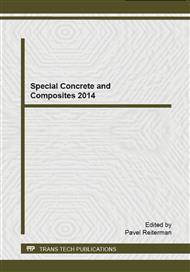p.11
p.17
p.22
p.27
p.33
p.37
p.43
p.48
p.54
Comparison of Refractory and Non-Refractory Components in Cement Composites after High Temperatures Load
Abstract:
This article shows results of experimental program focused on determination of refractory and non-refractory components for cement composites and those influence on final properties. According to several research works from various universities strength and cohesion in general of common concrete rapidly decrease with temperature higher than 600 °C. To determine the difference between fire-resistance and common components four mixtures were designed. Non-refractory crushed nature silica aggregates and Portland cement compared to high alumina cement Secar®71 with crushed nature basalt aggregates were used. Combination of basalt fibers with two different lengths significantly improves. Basic mechanical properties tensile characteristics such as tensile strength in bending and compressive strength were examined on samples 40 x 40 x 160 mm. Exposure to 600 °C and especially 1000 °C in electric furnace for three hours simulated the high temperature load. Compared to silica aggregates together with Portland cement, where after1000 °C the composite is disintegrated with almost zero strength, the refractory components show considerably better parameters.
Info:
Periodical:
Pages:
33-36
Citation:
Online since:
October 2014
Authors:
Price:
Сopyright:
© 2014 Trans Tech Publications Ltd. All Rights Reserved
Share:
Citation:


